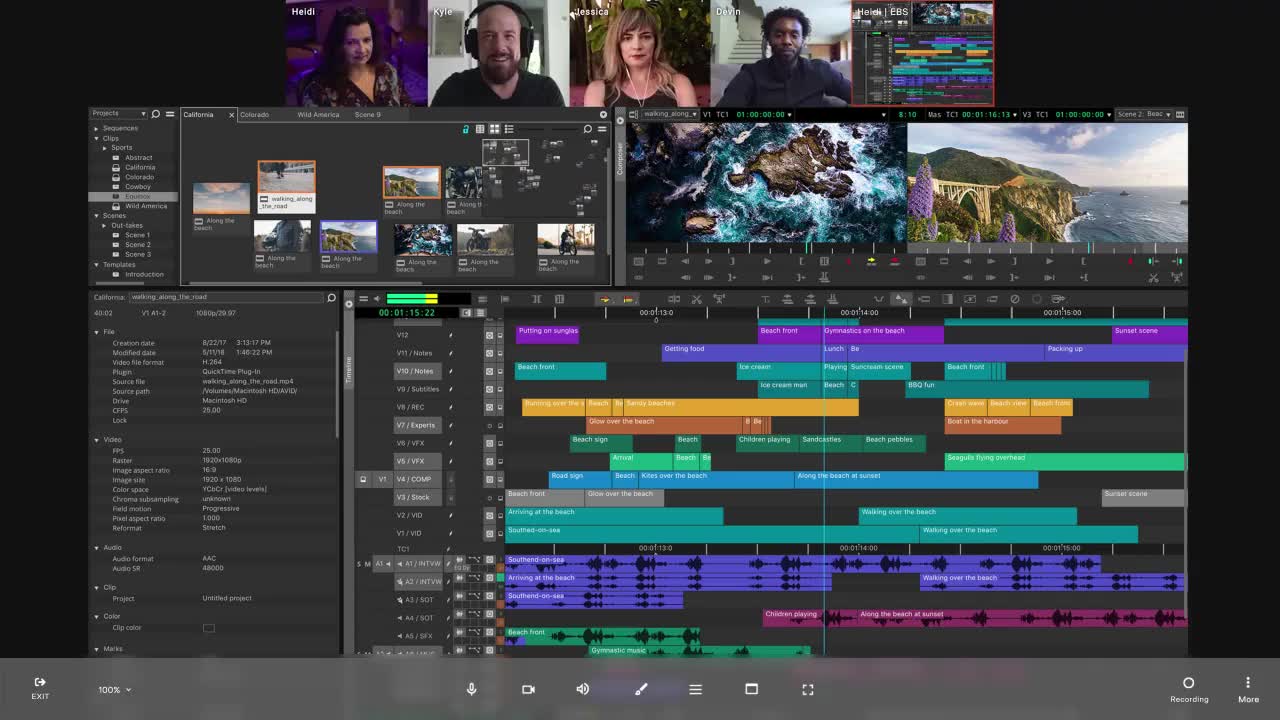The ability to live stream your workspace is essential for remote collaboration and project reviews with clients, whether you’re working together in Avid Media Composer, cutting in Premiere Pro, or editing in another software suite.
If you’ve ever tried collaborating through a traditional video conferencing tool, you likely experienced the debilitating lag that occurs without an optimized setup. Fortunately, several tools are available to help you streamline the process and stay in sync with your team throughout the creative process.
In this article, we share some of the most effective strategies to help you stream your complete editing workflow without lag.
Why streaming your editing software causes lag
Most consumer-grade streaming applications aren’t built to showcase professional software and video content. Zoom, for instance, automatically downgrades higher resolution to 1080p and compresses audio to minimize the bandwidth needed to power a session.
When you bypass these defaults, bandwidth can become extremely limited, leading to interruptions or delays in your stream. The same restrictions apply to other common video conferencing solutions like Microsoft Teams or Google Meet.
NLE editors and other video production software naturally take up a lot of CPU, which can reduce your computer’s performance, especially when simultaneously conducting a remote streaming session. General computer performance can also affect the quality of your stream.
The good news is creative professionals can leverage several effective software workarounds to help them stream without lag—or with significantly less margin for error.
5 ways to stream your editing software without lag
Here are a few streaming solutions to help you eliminate or minimize lag during your remote editing session.
Separate your stream components
If you have access to more than one device, reduce some of the burden on your computer by conducting the video conference on another machine. Have one computer dedicated to sharing your editing workflow, and use a separate device for calling in and communicating with your other session participants.
Consider hardware solutions
Professional editors like Sofi Marshall often invest in hardware like a capture card or web presenter tools to decrease lag and support high-resolution video. However, this solution can require more technical expertise. You have to know what’s compatible and needed for your specific setup.
This option can also be a somewhat larger upfront investment, especially if you’re not completely familiar with your computer specs and any external gear you may already have available.
Use OBS and NDI
You can combine Open Broadcast Software (OBS) and Network Device Interface (NDI) to stream several devices simultaneously through consumer-grade software like Zoom.
Once you acquire NDI and OBS (both free) alongside the core NDI tools, you can connect the two components using the OBS NDI plugin. Then, configure your streaming source (in this case, the screen capture of your editing workflow) within the NDI access manager.
You can then open OBS and add an NDI Source to your scene. Finally, you can stream the final scene directly through OBS or pair it with conferencing software like Zoom via the Virtual Camera feature.
We walk you through the entire setup process here. However, understand it’s not a standalone solution since you still need additional video conferencing software.
Use OBS + Zoom
Another option is to use OBS’ virtual camera feature via Zoom to stream your edit workflow, as explained in this guide.
Once you download the newest versions of OBS and Zoom, you can configure a “scene” on OBS that showcases the screen capture of your editing software. Next, open Zoom to select OBS Virtual Camera as the input source. Then, return to OBS and click Start Virtual Camera to begin streaming your editing workflow through Zoom.
While both resources are free, you have to work through setting up individual sources in OBS and Zoom before every stream, which can be cumbersome and time-consuming. You must also add a webcam source to your OBS stream or configure the video feed separately if you want to conference while editing remotely.
Use a standalone solution, like Evercast
Instead of trying to pull together spare parts, invest in software built by creative professionals for creative professionals. Evercast offers editors a simple software-only solution for sharing 4K workflows in real time, leaving frame-accurate annotations, and video conferencing—all within a single, secure software suite.
Top-of-the-line editors use Evercast and can attest to how well the platform supports collaboration across several countries, even continents.
“I’ve used a number of real-time video streaming services, but nothing comes close to the ease and reliability of integrating Evercast into the editing room workflow. Working between New Zealand, Los Angeles, Dominican Republic and London put Evercast to the test and it delivered.”
— Martin Brinkler, editor of 47 Meters Down: Uncaged

Most importantly, Evercast is optimized for live streaming, providing full HD with less than a 150-millisecond delay for a true over-the-shoulder experience. Whether you work from a desktop computer or take a more modernized approach with the Apple Vision Pro, the suite’s flexibility permits you and your team to collaborate from almost anywhere.
Create together remotely, in real time

Evercast also has plenty of other helpful features, including:
- Performs effortlessly with any workflow or editing process from pre- to post-production
- Genuine color accuracy, supporting up to 10-bit 4:4:4
- 5.1 and 7.1 surround sound support
- Ultra-low latency without any additional proprietary hardware required
- Security approved by all major film studios
- 24/7 white-glove support
- Records and plays back sessions with frame-accurate annotations
- Flexible access via dedicated apps for macOS, Windows, iPhone, iPad, and Apple TV
Book a live demo for your next editing session, or learn more about Evercast here.














